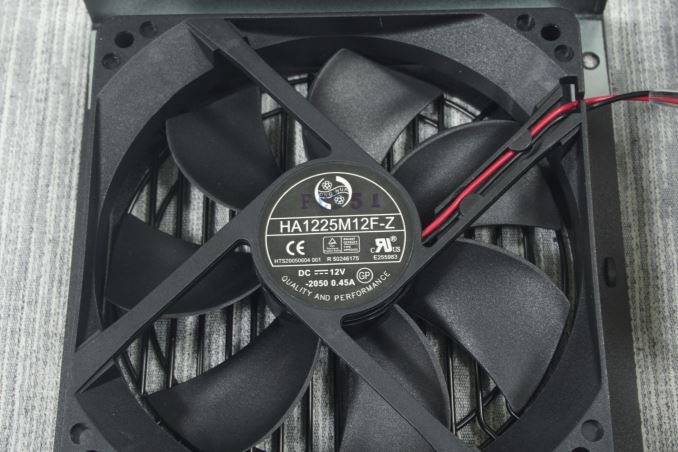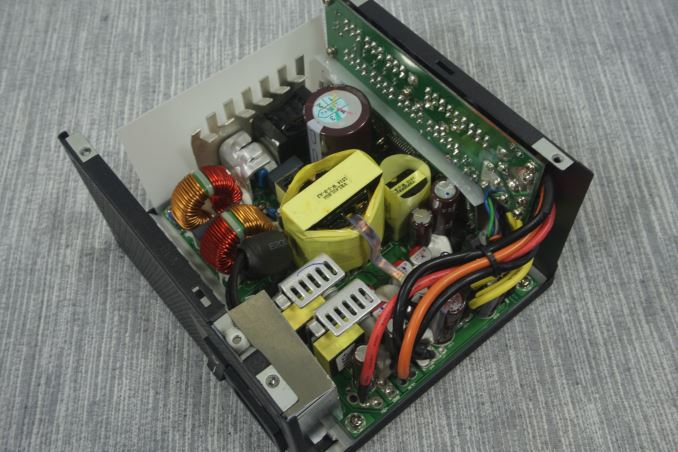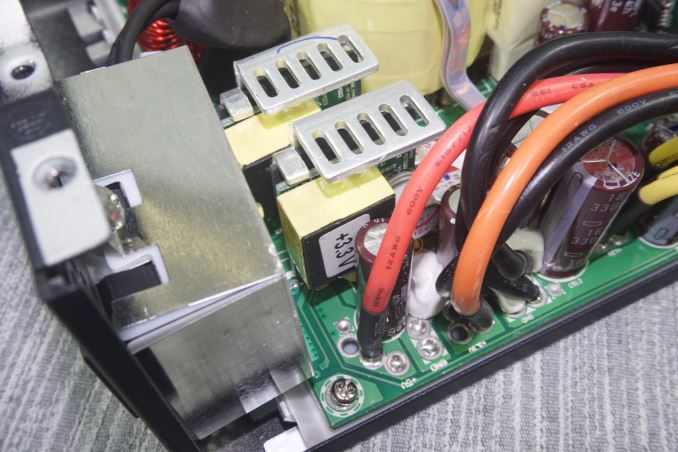The Cyonic AU-550x PSU Review
by E. Fylladitakis on August 17, 2015 8:00 AM EST- Posted in
- Cases/Cooling/PSUs
- Seasonic
- PSUs
- 550W
- Cyonic
External Appearance
The first thing one will notice about the Cyonic AU-550x is its very small proportions. It is built inside a chassis that is only 140 mm long, allowing it to fit even in the most peculiar cases that have a slot for an ATX PSU. The body is sprayed with a matte black paint and most of the top side is covered by a large sticker with the electrical specifications and certifications of the PSU. There are no stickers on the sides of the chassis, and Cyonic opted to punch the company name onto the metal surface and print the model and company logo using deep purple paint.
The connectors for the modular cables can be found at the front side of the chassis. It is interesting to note that there are three connectors for the 12V CPU and PCI Express cables but only two cables are supplied with the 550W version. A badge with the company logo has been installed above the standard on/off switch and AC cable receptacle at the rear side of the body. A parallel bars finger guard rests above the simple black fan.
Internal Design
Cyonic installed a 120 mm Hong Hua for the cooling needs of the AU-550x. The HA1225M12F-Z is a very powerful 2050 RPM model with a hydrodynamic bearing. Considering the mediocre power output of the PSU and its claimed high efficiency, it should be very difficult to force this fan to run anywhere near its maximum speed.
As it has been already mentioned, Seasonic is the OEM behind Cyonic PSUs. The Cyonic AU-550x (and all six of their currently available models) is based on a platform that looks like Seasonic's G-series, but it is not quite the same. The differences are not dramatic and appear to have been made in order to allow for the vertical board with the connectors to be installed so closely above the main PCB, i.e. to fit the platform inside the 140 mm chassis.
The filtering stage is at the back of the AC receptacle, with the components covered by a metallic shield in order to minimize EMI. We spotted a total of six Y capacitors, two X capacitors and two filtering inductors before the main rectification bridge. The main bridge has a small dedicated heatsink, densely packed next to a larger heatsink and the passive APFC components. There are no components directly attached on the heatsink near the edge of the PCB, as that heatsink is cooling the active components installed at the bottom of the main PCB. The large PFC 420V/470μF capacitor is supplied by Nippon Chemi-Con.
The secondary electrolytic capacitors are supplied by Nippon Chemi-Con as well, with a single capacitor coming from Rubycon. All polymer capacitors are supplied by Fujitsu. The 3.3V and 5V generation circuits were moved towards the AC receptacle and were given a small heatsink each. It is very interesting to note that this is the first unit that we have ever reviewed that makes use of board mount DC/DC converters. Essentially, Cyonic replaced most of the DC to DC conversion circuit with a "brick" converter for each of the two minor lines. These typically are of high efficiency and very compact, although they obviously are much more costly than a typical circuit. The energy is being transferred from the main PCB onto the vertical PCB via a few very thick wires, carefully tied to avoid creating a messy layout. Finally, a lot of glue has been used to maximize the mechanical strength of the PSU.


























30 Comments
View All Comments
marraco - Monday, August 17, 2015 - link
Anandtech needs to learn a lot about reviewing a PSU.Where are the power on tests? They are critical.
How does it behaves when each rail is fully loaded? Does it really deliver? Most PSU don't.
How much AC noise and ripple contains the signal under different loads? Those small peaks may slowly erode your hardware
E.Fyll - Monday, August 17, 2015 - link
By "Power On" tests, I assume that you are talking about the AC input and care about the inrush current and harmonics.Power On tests require a very good oscilloscope with current probes and a programmable AC source. These are equipment in the tens of thousands of dollars. Although there are plans to purchase them in the future, you need to excuse me that I do not possess such funds to spend for just a couple of more tests.
...and not practically useful tests either. Power On tests are everything but "critical". They are virtually limited to compliance certification. The inrush current or the harmonics generated by a PSU will not affect its performance. Harmonics may affect other very sensitive devices on the same line, such as audio equipment, but again these need to reach extraordinary levels to become an issue. Inrush current could cause your household circuit breaker to release if it is too high, but 99.99999999% of the readers cannot really calculate and compare the current-time (I-t) curve of a PSU against the I-t curve of the circuit breaker. If I gave them a curve with a maximum current of 170A over a few nanoseconds, most people would think that their house would catch fire, even though that figure is entirely unimportant. 99.99% cannot even differentiate between power and energy, they cannot comprehend that timeless figures do not tell any side of the story at all.
Now, if you are talking on the DC side, they become critical only if they fail their required specifications. It is very difficult for a PSU not to meet these standards. Once again, a very fast oscilloscope is required for proper testing, but I would report it if something was amiss with the oscilloscope that I am using right now.
The vast majority (99.9% or more) of the PSUs will behave just fine with each rail loaded to its maximum wattage and current specifications. Heavy ripple may appear due to the cross-loading, but I never saw a single PSU that would not work. We have the cross-loading tests just for that. And, by the way, loading a single rail to the maximum while the rest are unloaded is not a proper usage scenario. By that logic, I should be testing them on mount Everest, just to see if they can work at an altitude of 5000 meters. Even for our cross loading tests, the load is terribly unbalanced and it is virtually impossible to represent a real world scenario. Well, unless if what you want to do is to use a PSU to start a car's engine or to power a welder.
And since we are on the topic of learning, you can have AC signal on your DC signal (that's ripple) and random fluctuations (that's noise). Page 4 for ripple. For noise, once again you need a VERY expensive oscilloscope, capable of calculating and displaying ripple and noise separately. My equipment cannot currently filter the noise out of a signal.
And yes, ripple is one of the most important PSU characteristics in my opinion, as it has a significant effect on the lifetime of electronics.
ImSpartacus - Tuesday, August 18, 2015 - link
Whoa, let's calm down there, hondo.It's not worth arguing with random people on the internet.
It's good to read comments and feedback, but spend your time writing articles, not massive comments.
dqniel - Tuesday, August 18, 2015 - link
His comment was filled with useful information, so I'm glad he posted it.marraco - Monday, August 24, 2015 - link
Thanks for your answer.I apologize, because for some reason I didn't noticed the ripple data in page 4. Thanks for including it.
Some sites specialized on PSU analysis compare each unit with the certificated specification standards, and other units.
I learnt about the importance of ripple and power on behavior when one of my motherboards died, and a friend told me that my PSU had bad behavior, so the ripple probably damaged it enough for the bad peaks at power on to finish the work.
He was working at a university, so he didn’t pay for the equipment. I didn’t knew that it was so expensive.
I'm sorry to hear that you do not have that expensive equipment. I'm accostumed to find here reviews of expensive hardware, and forgot that generally it is lendt or donated by manufacturers.
kuttan - Monday, August 24, 2015 - link
No worry here a good review which is easy to understand and informative. So sites go too much technical in a sense that you need to poses a PhD in electrical science to understand what they say. Some sites do review the opposite way that they do some basic load tests and efficiency tests I'm not naming it who. Anandtech PSU reviews are overall balanced and yet detailed enough.Folterknecht - Monday, August 17, 2015 - link
Can't remember when/if I saw a Seasonic (based) PSU with 60 mV Ripple, that usually their strong point - bad Sample?@jonnyGURU:
If you 're working for Corsair now - that's at least what I assume after seeing you in a Techsyndikate Interview regarding single/multi rail designs "recently" - commenting on on a competitiors product seems odd to me.
sheh - Tuesday, August 18, 2015 - link
I still think it would be useful to test with a 50W load, and even 25W. Modern computers don't use much power in light usage.Beaver M. - Tuesday, August 18, 2015 - link
Exactly. A test like that is mandatory nowadays. You can actually get systems down to 10-15W, if you put some effort into it.DanNeely - Wednesday, August 19, 2015 - link
It was tested at a sub 50W load. Eyeballing it I'd say it's at most 30W; might only be 25.